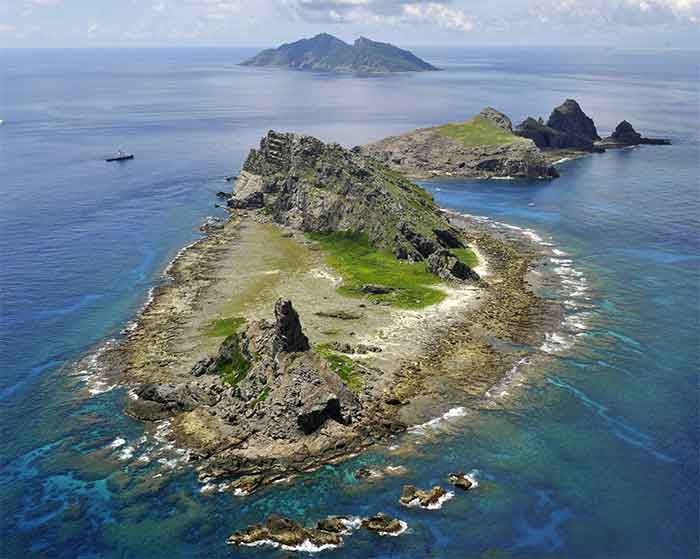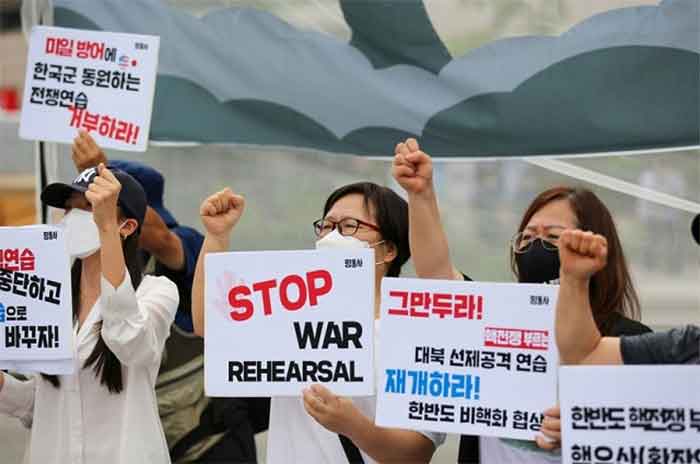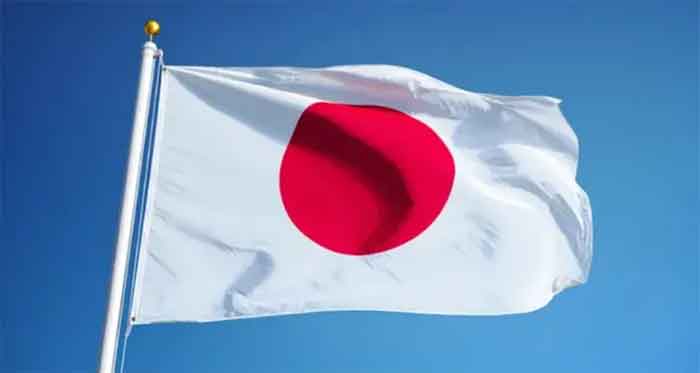
Common knowledge informs us that the surrender of Imperial Japan on August 15, 1945 brought an end to the Japanese empire and Japan’s occupation of all areas and countries that had been taken as a result of its military aggression. The Allied Cairo Declaration of 1943, for example, stated: “. . . all the territories Japan has stolen from the Chinese, such as Manchuria, Formosa [Taiwan], and The Pescadores, shall be restored to the Republic of China. Japan will also be expelled from all other territories which she has taken by violence and greed.”
While, on the whole, the stipulations of the Cairo Declaration were carried out following Japan’s defeat, the question is, was Japan expelled from all territories it had taken by “violence and greed,” especially those territories stolen from China? Many readers will be surprised to learn that, in fact, Japan did not return all the territories it had stolen from China. And even more surprisingly, one of Japan’s most bitter wartime enemies, i.e. the United States, now continues to guarantee, under threat of military force, that the last remaining stolen territories will not be returned to China. How can this be?
First, the territories not yet returned to China refers to the Senkaku (Ch. Diaoyu) Islands. Japan claims these islands have been part of its territory since 1895, justifying their ownership on the basis that Japan conducted surveys of the islands in 1884 and found them to be terra nullius, i.e. with no evidence to indicate they were under China’s control or that of any country. The reality, however, is that the Senkaku Islands were first mentioned in a 15th century Chinese document describing a voyage to the Ryukyus [Okinawa] from China. By the 17th century, Chinese sources clearly named the maritime boundary between the Senkaku Islands and the Ryukyus as the Heishuigou or ‘Black Water Trench’, an area of high turbulence that marks the edge of China’s continental shelf.
In 1720, deputy Chinese envoy Xu Baoguang collaborated with local Ryukyuan authors to compile the travelogue Zhongshan Chuanxin Lu or ‘Record of the Mission to Chusan’, which demarcated the westernmost border of the Ryukyuan kingdom at Kume-jima, south of the Black Water Trench. In 1879, Japan unilaterally annexed the Ryukyu Kingdom, turning it into Okinawa Prefecture and forcing its king to relocate to Tokyo. This occurred eleven years after the creation of modern Japan resulting from the Meiji Restoration of 1868. Significantly, however, it was not until 1885 that the governor of Okinawa, Nishimura Sutezo, petitioned the Meiji government to take control of the Senkaku Islands. In response, Minister of Foreign Affairs Inoue Kaoru noted that the islands lay near the border area with China and already had Chinese names.
Inoue also cited an article in a Chinese newspaper charging that Japan was occupying islands off China’s coast. Inoue feared that a Japanese claim on the Islands would anger China, possibly leading to war, a war for which Japan was not yet ready. Inoue’s concerns convinced Yamagata Aritomo, Minister of the Interior, to refuse the governor’s request. Furthermore, correspondence between Inoue and Yamagata in 1885 warned against the erection of national markers and developing the islands’ land to avoid China’s suspicions.
As a result, it was not until ten years later, i.e. January 14, 1895, in the closing stages of the First Sino-Japanese War of 1894–1895, that Japan, in a secret Cabinet decision, took control of the Senkakus. By that time, Japan was certain of victory and knew there was nothing China could do about the takeover. The Senkakus were, in fact, Japan’s first modern senka (fruits of war).
By incorporating the islands prior to the Shimonoseki Peace Treaty between the two nations of April 17, 1895, Japan sought to ensure that even if the Western colonial powers intervened to block Japan’s acquisition of still more Chinese land, it would at least have succeeded in acquiring these islands. Subsequently, this allowed Japan to claim that since the takeover had taken place prior to the Peace Treaty, the Senkaku Islands were not included in its terms. The same reasoning allowed Japan to claim, however falsely, that none of the Allied declarations at the end of WWII required Japan to relinquish control of the islands since they hadn’t been acquired through military aggression but were an inherent part of its territory.
After World War II, instead of returning the Senkakus to China, the US-sponsored San Francisco Peace Treaty of 1951 placed the Senkaku Islands under the administration of the United States as part of Okinawa, which the US continued to occupy. When Okinawa was finally returned to Japan in 1972, the Senkaku Islands were included as part of the area over which the administrative rights were returned. All of this was done without any consultation with the People’s Republic of China (PRC) or, for that matter, with the Republic of China (ROC) on Taiwan.
Since the Nixon administration, the United States has taken the position that territorial sovereignty over the Senkaku Islands was to be decided by the parties involved — Japan, the PRC and the ROC on Taiwan. However, this changed in 2014 when Barack Obama became the first sitting US president to verbally declare that the United States would defend the islands if attacked since they were under Japanese administration .
In February 2017, US President Donald Trump further enhanced the US commitment to the Senkaku Islands. In a joint written declaration with former Japanese prime minister Shinzo Abe, Trump expressly stated that the Japan–US Security Treaty applies to the Senkaku Islands and that the US opposes all unilateral actions aimed at contesting Japan’s administration over the islands. Trump thus became the first US president to express in writing the US obligation to defend the Senkakus without mentioning the provisional nature of Japanese sovereignty.
During his visit to Japan in early October 2020, US Secretary of State Mike Pompeo called ‘for a new alliance of democracies’ to counter the PRC. Meanwhile, at the end of October, Japan and the US began air, sea and land exercises around Japan in the face of increased PRC military activity in the region. Commander of US Forces Japan Lieutenant General Kevin Schneider stated that “the United States is 100 per cent absolutely steadfast in its commitment to help the government of Japan with the situation [of defending the Senkaku Islands]. That’s 365 days a year, 24 hours a day, seven days a week.”
The US commitment expressed by Pompeo and Schneider was welcomed by about 100 legislators in Japan’s governing Liberal Democratic Party who called for joint Japanese and US military operations to strengthen control over the Senkaku Islands. The legislators’ proposal made clear that the ownership of the Senkakus remains an important issue for Japan, with numerous related articles in the Japanese press reporting on the PRC’s incursions into the waters surrounding them.
On the one hand, the US states it takes no position on the ultimate sovereignty over the Senkakus and recognizes the obvious, i.e. they are currently under Japan’s administration. This suggests that the US understands the shaky historical roots of Japan’s takeover of the islands and recognizes, at least to some degree, that the PRC has a legitimate claim to the islands. Nevertheless, the US is clearly ready to go to war to defend Japan’s administrative rights. But why does the US back one of Japan’s earliest imperial conquests so strongly?
First, this represents a chance for the US military to lessen the Japanese people’s opposition to US military bases in Japan, especially in Okinawa where there remains strong opposition to the 32 military installations in that prefecture. In other words, the US military can present itself as actually protecting Japanese territorial integrity rather than endangering Japan by virtue of attacks on US bases in Japan in the event of a resumption of the Korean War.
Second, the US commitment to defend the Senkakus from a PRC takeover serves to cement in place Japan’s role as a key link in the so-called “first island chain” whose purpose is to contain the PRC by ensuring its navy cannot break through the chain to operate in the Pacific Ocean. Small and uninhabited though they be, the Senkakus are nevertheless strategically located between the southernmost islands of Okinawa Prefecture and Taiwan so as to block the PRC Navy’s access to the Pacific.
Third, as a result of increased tensions over Taiwan’s future, the US military has war-gamed the possibility of conflict with the PRC 18 times and 18 times the US lost. With Japan already in possession of the world’s fifth strongest military, the US actually needs the Japanese military to ensure it will emerge victorious in a conventional war with the PRC that does not employ nuclear weapons. And Japan’s conservative elites are only too happy to use the alleged threat from the PRC over Taiwan as a pretext to further enlarge the Japanese military, including revision of the last remaining brake on Japan’s ability to conduct warfare abroad – Article Nine of Japan’s peace constitution.
At a June 2021 meeting of the conservative Hudson Institute think tank, Japan’s Deputy Defense Minister Nakayama Yasuhide said democratic countries had to protect each other and noted that he had in the past referred to Taiwan as a “red line.” In a major break with past Japanese self-defense policy, Nakayama explicitly said, “So we have to protect Taiwan as a democratic country.” Nakayama justified his statement by pointing out that Japan and Taiwan were geographically close, so if something happened in Taiwan it would affect Japan’s Okinawa Prefecture where US forces and their families are based. “So wake up. We have to wake up! ” he concluded.
In light of the fact that it was Japan that first used military force to wrest Taiwan from China as a result of its victory in the Sino-Japanese War of 1894-5, it is ironic that Japan is once again at the forefront of ensuring, this time in combination with the US, that Taiwan will remain separated from its compatriots in mainland China. Albeit for entirely different reasons, I find myself in agreement with Nakayama’s call to “Wake up!” Wake up, that is, to the need for a sincere diplomatic dialogue between Japan and the PRC over a just and equitable disposition of the Senkaku Islands.
Brian Victoria, Ph.D., Senior Research Fellow, Oxford Centre for Buddhist Studies













































